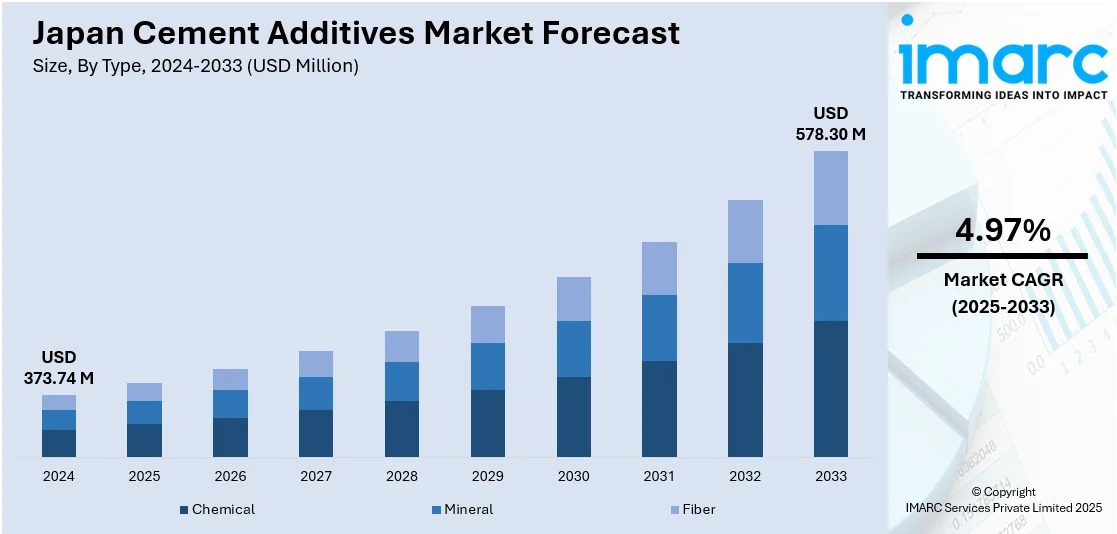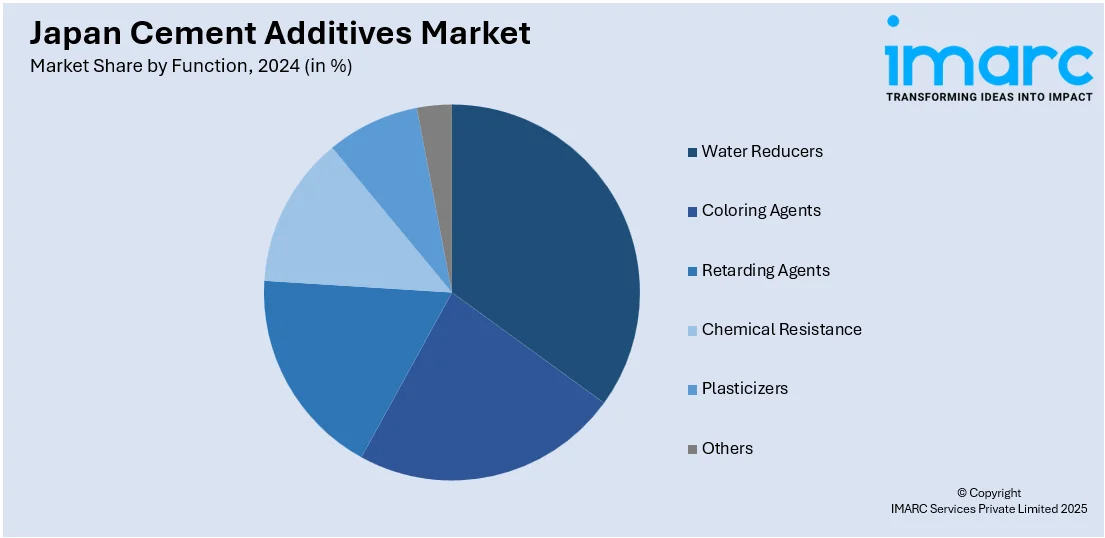
Japan Cement Additives Market Size, Share, Trends and Forecast by Type, Function, and Region, 2025-2033
Japan Cement Additives Market Overview:
The Japan cement additives market size reached USD 373.74 Million in 2024. Looking forward, IMARC Group expects the market to reach USD 578.30 Million by 2033, exhibiting a growth rate (CAGR) of 4.97% during 2025-2033. Japan's growing infrastructure investments, shift towards modular housing, and increasing focus on high-quality concrete for specialty applications are driving the demand for cement additives. These additives improve durability, strength, and resistance, supporting sustainable construction and large-scale, specialized projects. This rising demand for advanced construction solutions is contributing to the growth of the Japan cement additives market share, as companies seek to improve the performance and longevity of concrete in numerous infrastructure and building projects.
|
Report Attribute
|
Key Statistics
|
|---|---|
|
Base Year
|
2024 |
|
Forecast Years
|
2025-2033
|
|
Historical Years
|
2019-2024
|
| Market Size in 2024 | USD 373.74 Million |
| Market Forecast in 2033 | USD 578.30 Million |
| Market Growth Rate 2025-2033 | 4.97% |
Japan Cement Additives Market Trends:
Growing Infrastructure Investments
The increasing investments in infrastructure development in Japan are catalyzing the demand for cement additives. The government and private sector are both prioritizing the renewal of old infrastructure like bridges, roads, public facilities, and the expansion of transportation systems. This trend is driving the need for specialized cement mixtures that provide improved durability, long-lasting performance, and resistance to damage and deterioration. Cement additives are essential for enhancing strength, lowering maintenance expenses, and prolonging the durability of structures. In line with this trend, the Tokyo Outer Ring Road (Gaikan Expressway) expansion initiative was revealed in 2024. As the most significant infrastructure endeavor in Japan, this 85-kilometer project aimed to enhance regional connectivity, alleviate traffic congestion, and facilitate smart city integration. The initiative further highlighted the use of environment-friendly materials and sustainable building methods, which further increases the need for high-performance cement additives.

Shift Toward Modular and Prefabricated Housing
Modular and prefabricated homes are becoming popular in Japan as a budget-friendly and effective way to address the rising housing needs. This trend is catalyzing the demand for specialized cement products utilized in off-site construction, with cement additives being essential for guaranteeing the effectiveness of precast elements. These additives allow for quicker setting times, enhanced durability, and simplified transport and assembly, which are crucial for extensive, swift production. The rising shift towards modular and prefabricated homes is propelling the Japan cement additives market growth, as these materials adhere to stringent quality standards for fast and effective building. Moreover, Japan's modular building market attained USD 17.10 billion in 2024, and is predicted to expand to USD 27.70 billion by 2033, experiencing a CAGR of 5.89% from 2025 to 2033, as per the IMARC Group. This expansion underscores the growing need for cement additives to improve construction.
Rising Focus on High-Quality Concrete in Specialty Applications
Specialty applications, such as the construction of seismic-resistant structures, high-rise buildings, and marine structures, are becoming more prevalent in Japan's construction industry. These initiatives demand concrete that offers increased strength, flexibility, and resistance to natural disasters, especially due to Japan's susceptibility to earthquakes and other severe occurrences. Cement additives are vital for enhancing features like crack resistance, water resistance, and flexibility in difficult conditions. The need for durable, high-performance concrete is encouraging the use of these additives in specific concrete formulations. The finishing of Japan's highest structure in 2024, the 330-meter Mori JP Tower in Tokyo's Azabudai Hills by Pelli Clarke & Partners, demonstrates the necessity for premium concrete. This multi-functional tower, featured upscale residences, a hotel, and sustainable elements, including rainwater collection and renewable energy. Such projects are catalyzing the demand for innovative cement additives in Japan’s changing construction environment.
Japan Cement Additives Market Segmentation:
IMARC Group provides an analysis of the key trends in each segment of the market, along with forecasts at the country and regional levels for 2025-2033. Our report has categorized the market based on type and function.
Type Insights:
- Chemical
- Mineral
- Fiber
The report has provided a detailed breakup and analysis of the market based on the type. This includes chemical, mineral, and fiber.
Function Insights:

- Water Reducers
- Coloring Agents
- Retarding Agents
- Chemical Resistance
- Plasticizers
- Others
A detailed breakup and analysis of the market based on the function have also been provided in the report. This includes water reducers, coloring agents, retarding agents, chemical resistance, plasticizers, and others.
Regional Insights:
- Kanto Region
- Kansai/Kinki Region
- Central/ Chubu Region
- Kyushu-Okinawa Region
- Tohoku Region
- Chugoku Region
- Hokkaido Region
- Shikoku Region
The report has also provided a comprehensive analysis of all the major regional markets, which include Kanto Region, Kansai/Kinki Region, Central/ Chubu Region, Kyushu-Okinawa Region, Tohoku Region, Chugoku Region, Hokkaido Region, and Shikoku Region.
Competitive Landscape:
The market research report has also provided a comprehensive analysis of the competitive landscape. Competitive analysis such as market structure, key player positioning, top winning strategies, competitive dashboard, and company evaluation quadrant has been covered in the report. Also, detailed profiles of all major companies have been provided.
Japan Cement Additives Market Report Coverage:
| Report Features | Details |
|---|---|
| Base Year of the Analysis | 2024 |
| Historical Period | 2019-2024 |
| Forecast Period | 2025-2033 |
| Units | Million USD |
| Scope of the Report |
Exploration of Historical Trends and Market Outlook, Industry Catalysts and Challenges, Segment-Wise Historical and Future Market Assessment:
|
| Types Covered | Chemical, Mineral, Fiber |
| Functions Covered | Water Reducers, Coloring Agents, Retarding Agents, Chemical Resistance, Plasticizers, Others |
| Regions Covered | Kanto Region, Kansai/Kinki Region, Central/ Chubu Region, Kyushu-Okinawa Region, Tohoku Region, Chugoku Region, Hokkaido Region, Shikoku Region |
| Customization Scope | 10% Free Customization |
| Post-Sale Analyst Support | 10-12 Weeks |
| Delivery Format | PDF and Excel through Email (We can also provide the editable version of the report in PPT/Word format on special request) |
Key Questions Answered in This Report:
- How has the Japan cement additives market performed so far and how will it perform in the coming years?
- What is the breakup of the Japan cement additives market on the basis of type?
- What is the breakup of the Japan cement additives market on the basis of function?
- What is the breakup of the Japan cement additives market on the basis of region?
- What are the various stages in the value chain of the Japan cement additives market?
- What are the key driving factors and challenges in the Japan cement additives market?
- What is the structure of the Japan cement additives market and who are the key players?
- What is the degree of competition in the Japan cement additives market?
Key Benefits for Stakeholders:
- IMARC’s industry report offers a comprehensive quantitative analysis of various market segments, historical and current market trends, market forecasts, and dynamics of the Japan cement additives market from 2019-2033.
- The research report provides the latest information on the market drivers, challenges, and opportunities in the Japan cement additives market.
- Porter's five forces analysis assist stakeholders in assessing the impact of new entrants, competitive rivalry, supplier power, buyer power, and the threat of substitution. It helps stakeholders to analyze the level of competition within the Japan cement additives industry and its attractiveness.
- Competitive landscape allows stakeholders to understand their competitive environment and provides an insight into the current positions of key players in the market.
Need more help?
- Speak to our experienced analysts for insights on the current market scenarios.
- Include additional segments and countries to customize the report as per your requirement.
- Gain an unparalleled competitive advantage in your domain by understanding how to utilize the report and positively impacting your operations and revenue.
- For further assistance, please connect with our analysts.
 Request Customization
Request Customization
 Speak to an Analyst
Speak to an Analyst
 Request Brochure
Request Brochure
 Inquire Before Buying
Inquire Before Buying




.webp)




.webp)












